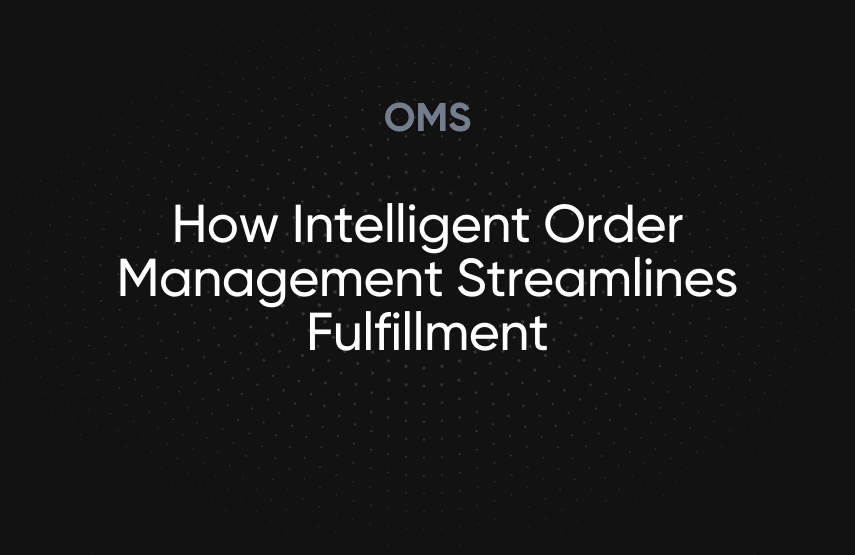How Intelligent Order Management Streamlines Fulfillment

Many businesses don’t have inventory visibility for ensuring data accuracy and faster order fulfillment.
AI-based order management systems are scalable solutions for business owners looking to automate, improve, and streamline their order lifecycle.
AI-based systems use Computer Vision technology, reinforced learning, and predictive behavior patterns to handle customer orders.
Businesses can use Microsoft Dynamics order management to streamline order fulfillment with AI.
23% of businesses don’t have inventory visibility of their supply chain. This is the leading cause of over and understocking inventory issues. For business owners, this means significant sales losses and ruined customer relationships. But what if you could foresee these challenges beforehand?
Technology is transforming how businesses operate, and Artificial intelligence (AI) is becoming a major pioneer to a system where you just need to push a button to get things done.
The spreadsheet method of collecting customer insights is becoming outdated. In this article, you’ll learn how to replace spreadsheets with AI-based systems. You’ll also learn how leveraging intelligent order management can streamline your workflow.
[toc-embed headline=”Intelligent Order Management System Overview”]
Intelligent Order Management System Overview
Intelligent order management is best described in the words of Stephanie Dart, Director of product marketing at Dynamics 365:
“Intelligent order management uses machine learning to learn how business users react to each exception and provide better recommendations each time, helping them achieve optimal stock levels and improve cash flow.”
AI in order management refers to when order and inventory management systems perform tasks or functions that are usually done by humans. These tasks include:
- Automating and streamlining order fulfillment processes, such as accepting customer orders, monitoring, and updating inventory levels
- Collating data and analyzing customer insights for predicting demand patterns
- Merging inventory and sales data
- Enabling employees and customers to view and track each order from start to finish
- Assisting in scaling cross-border sales
- Handling reverse logistics
[toc-embed headline=”How AI Works in Order Management”]
How AI Works in Order Management
Predict customer demands
Intelligent order management gathers customer insights based on purchase trends, responses to promotions and sales, and historic analysis. Using this data, AI-based order management systems can predict customer demands.
They can also streamline the order lifecycle using both structured and unstructured data. Structured data are plain and quantifiable numerical entities, like the number of warehouses you own and your stock levels. While unstructured data refers to images, texts, or videos obtained from security cameras in your warehouses.
Prevent stocking issues
Most business owners prefer to use manual solutions like Excel spreadsheets to log inventory. While they are cost-effective, human error is more prominent. This contributes to inventory and shipping errors.
AI-based systems can use the Synthetic Minority Oversampling Technique (SMOTE) to balance out inventory data and prevent stocking issues. This will help determine the right amount of products to stock your warehouses with.
Improve inventory visibility
AI-based order management systems also utilize reinforcement learning. This is when robotics are trained to adapt to real-time conditions on their own the way a human being would.
With reinforced learning, SMOTE sampling techniques, and predictive behavior patterns, AI-based systems can improve inventory visibility. This helps to ensure your customers get exactly what they ordered and with fast speed.
[toc-embed headline=”How Intelligent Order Management Systems Work”]
How Intelligent Order Management Systems Work
A typical intelligent order management process looks like this:
- Customers place an order on your sales channel, like a website or marketplaces like Amazon and eBay.
- You receive and accept the order via your order management software (OMS).
- The software generates an automated confirmation message and sends it to the customer.
- The OMS routes the order to the appropriate warehouse.
- Cameras in the warehouses detect and scan items for SKUs using Computer Vision.
- Machines translate the unstructured data into text commands using Optical Character Recognition (OCR) and Natural Language Processing (NLP) technology. This will help the software process the order before packaging.
- Robots or machines receive and scan the SKUs of items and pack the ordered items. Scanning SKUs allow machines to group multiple SKUs under one order to ensure items are shipped at the same time.
- Cameras help the robots know where to place items and prevent collisions that could damage the items.
- The robots transport and load the items into trucks for shipping.
- AI software uses route optimization to suggest the best routes for avoiding bad weather and road conditions until the package arrives at its destination.
[toc-embed headline=”Best Practices for Using Intelligent Order Management”]
Best Practices for Using Intelligent Order Management
Understand your business
Understanding your business structure will help determine whether to leverage AI or stick to standalone OMS. Draw a flowchart of your order fulfillment processes and pinpoint critical areas and bottlenecks.
If you strongly feel automation can resolve the bottlenecks, then move on to examine your operational maturity. This simply refers to how stable your business is.
Here are some key questions to ask to determine operational maturity:
- Are your processes defined?
- Are processes being consistently executed?
- Are your resources currently well planned and allocated? How many resources would it cost you to implement an AI-based system? Can your business spare the resources?
Hire professionals in AI-based systems
To set up an AI-based system, you need a team of experts who understand data science and can leverage DevOps, Python, Java, QA, and business analytic tools to track and monitor relevant insights for your business.
Choose a tech stack
A tech stack is a collection of software or applications to achieve a purpose. In this case, control robots and machines for intelligent order management.
The perfect tech stack combines programming languages, a solid database, intuitive frontend and backend tools, and API integration. You can use software like Microsoft Dynamics order management system.
The software is equipped with a drag-and-drop designer to let you configure order flows and processes easily. You can also gain real-time customer insights and integrate with other systems across multiple warehouses.

Tech advocate and writer @ fabric.